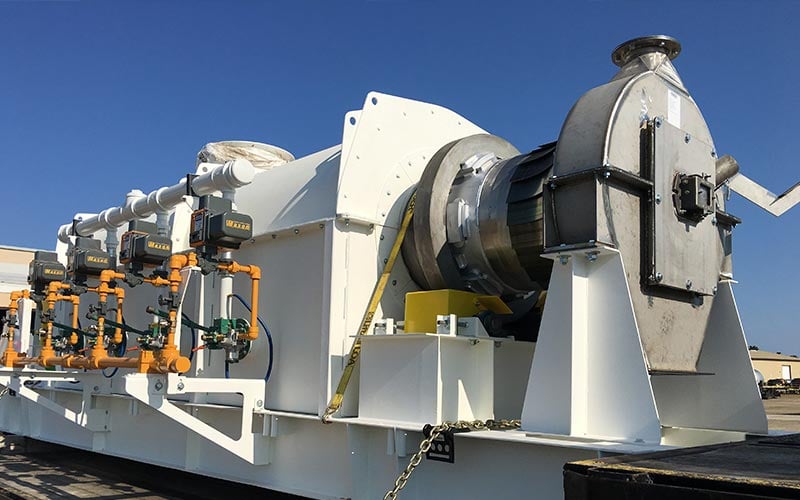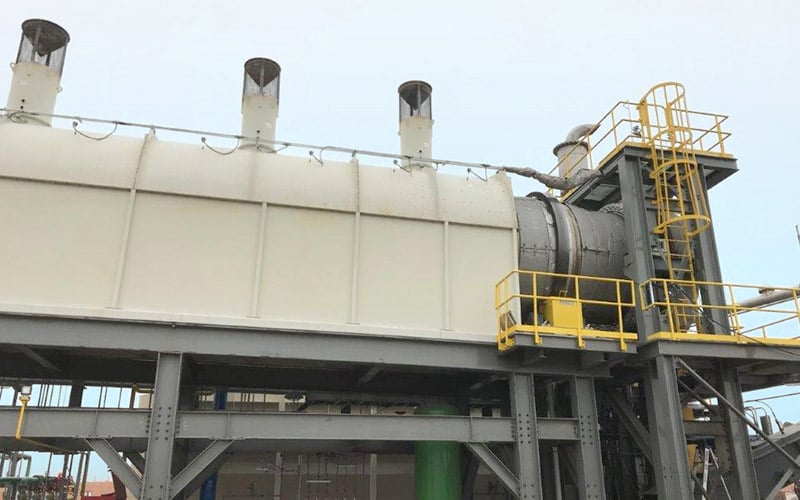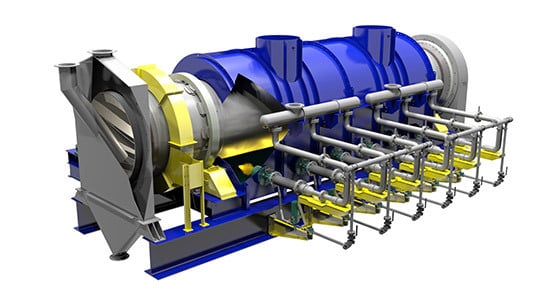Indirect-fired rotary kilns, also commonly called calciners, are a specialized thermal processing machine used to cause chemical reactions and phase changes in materials for a variety of industrial purposes. Used in settings where the processing environment must be kept inert, or where entrainment of fines is a concern, indirect kilns provide a valuable option to specialized thermal processing needs.
While indirect-fired rotary kilns offer a reliable processing solution, the aggressive processing they endure typically allots them a shorter lifespan as compared to their direct-fired counterparts; properly designed and maintained direct-fired kilns are rarely replaced, in general, operating reliably for decades. Conversely, indirect-fired kilns typically require replacement every 7-10 years, depending on the specific operating conditions.
The specialized nature of the indirect-fired rotary kiln requires careful planning and preparation for replacement in order to keep downtime and associated costs to a minimum. The following considerations should be kept in mind when replacement is on the horizon.

Indirect-fired FEECO rotary kiln prepared for shipment
Be Proactive About Replacement
It’s safe to say that prolonging the need for replacement is a goal in most settings utilizing an indirect rotary kiln. Replacement should never, however, be delayed to the point that catastrophic failure is allowed to occur.
Indirect-fired kilns are highly engineered and specialized machines tailored around the specific operation in which they are employed. Even in the most simple scenario when an exact duplicate is required, and the OEM can manufacture the unit, the process of acquiring a replacement kiln can take several months.
For this reason, it is crucial to take a proactive approach to replacement.
Recognizing the Need for Replacement
The challenge with indirect kilns is that the unit itself is housed inside a furnace, so problems are often not visible from the exterior; a cracked or out-of-round shell may go unnoticed for an extended period of time unless processing conditions or product quality are noticeably affected. Far too often, problems go unnoticed until a catastrophic failure occurs, bringing the operation to a standstill.
For this reason, and because damage often occurs gradually over time, careful monitoring of the unit and process conditions are essential in recognizing the onset of a problem. Operators and maintenance technicians should be properly trained in their duties, and process data, along with any maintenance and repairs, should all be thoroughly recorded in a log book. This will allow operators to recognize changes that may be occurring slowly over time. A more in-depth annual inspection by the OEM or other qualified technician is also an excellent way to gather benchmark data and thoroughly assess the unit’s condition on a regular basis.
Repair vs. Replacement
Depending on the type of damage, an indirect-fired rotary kiln may be repairable. When minor damage occurs, repairs can be made to keep the unit operational, but are only a temporary solution. Many indirect kiln operators continue to repeatedly repair the unit, but once the integrity of the kiln has been compromised, the need for replacement is only a matter of time, and the longer the delay, the more likely a catastrophic failure will occur.
Replacement Considerations
When it comes time to replace an indirect-fired rotary kiln, there are several considerations to keep in mind.
Failure Analysis
When an indirect-fired kiln fails, it’s important to understand why it failed, even when the kiln has simply reached the end of its useful life. Having an experienced technician conduct a failure analysis often reveals improvements that could be made during the design of the replacement unit. Could a different material promote a longer life span? Could a material flow problem be alleviated with an adjustment in the design?
A pressing timeline may be a temptation to overlook the cause of failure, but an assessment could save significant time and expense in the future.
Selecting a Vendor
There are many aspects to consider in selecting a rotary kiln manufacturer. If the original equipment manufacturer will not be providing the replacement kiln, keep in mind that careful vendor selection is an important step in a successful replacement.
Data Required in Replacing an Indirect-Fired Rotary Kiln
The data required may differ based on whether or not the original equipment manufacturer is selected as the replacement vendor. The OEM will typically have the original design on-hand, and will only need to be made aware of any changes that might be required.
When selecting a new rotary kiln manufacturer, a wide range of data is required. Depending on the specific scenario, baseline data needed for a rotary kiln replacement might include:
Existing Kiln Details:
- Dimensions (ideally, this is provided through the original drawings)
- Spatial restrictions
- Materials of construction
- Required exhaust gas treatment
Material Details:
- Feed rate
- Moisture content
- Chemical composition
- Temperature
- Bulk density
- Heat capacity
- Particle size distribution
- Foreign matter content
- Nature of feed (corrosive, sticky, free-flowing, toxic, etc.)
Product Details:
- Product rate
- Particle size distribution
- Moisture content
Process Details:
- Reaction temperature
- Maximum allowable temperature
- Total retention time required
- Heat of reaction
- Mode of heating
- Heat source
Logistics of Replacement
Perhaps the most challenging aspect of replacing a rotary kiln, be it indirect-fired or direct-fired, is the actual logistics of getting the old unit out and the new unit in.

Indirect Rotary Kiln used for drilling mud recovery
Spatial Constraints & Building Modifications
As a substantial piece of production equipment, facilities are often designed and built around the kiln, with little consideration given to the need for replacement down the road. The unit may be restricted by spatial constraints, making tear-down difficult, or other production equipment may need to be moved in preparation.
If there is not a door large enough to accommodate the new kiln, a temporary opening in the roof or sidewall may be necessary. These factors, along with the rigging required to carry out the replacement, are all essential preparations that will need to be made in advance.
Will Any Existing Components be Reused?
In some cases, it may be possible to reuse some of the existing components, such as tires, trunnions, and drive systems. While this is not an option in all cases, it can be helpful in reducing the cost of the replacement unit, though this advantage may be outweighed by some of the challenges that can accompany the use of existing components.
Will the New Unit Need to be Stored On-Site Prior to Install?
Consider that the timelines associated with the arrival of the new unit and removal of the old kiln will not necessarily line up. While ideally they will be as close as possible, on-site storage of the new kiln may be necessary for a time. If the new kiln is to be stored on-site for any length of time, accommodations will need to be made.
Conclusion
Indirect-fired rotary kilns provide a much-needed production tool for specialized thermal processing demands. Their critical role in processing requires a preventative approach to replacement, which must take a variety of considerations into account, from recognizing the need for replacement, to improving on the design, and uncovering the logistical needs of the actual replacement.
From assessing the original design, to inspecting the unit for cause of failure and engineering a seamless replacement, FEECO is known globally for the best in custom rotary kilns and parts and service support. For more information, contact us today!

